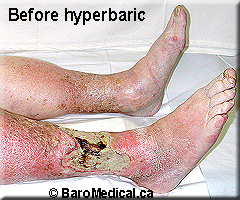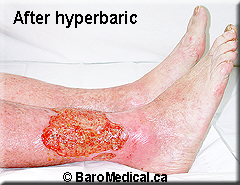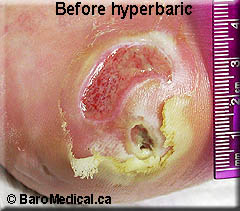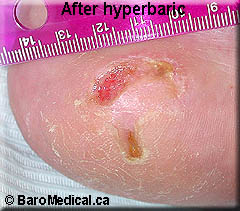Ulcers due to Peripheral Vascular Disease (PVD): Chronic Venous Insufficiency (CVI)
Chronic Venous Insufficiency is a venous disease that can cause venous ulcer. Origin of CVI is venous valve malfunction leading to blood pooling and hypertension of the venous system. This increased venous pressure can cause micro-vascular lack of blood perfusion (ischemia) and swelling. Swelling can further impair tissue nutrition and oxygen diffusion causing hypoxia.
Ischemia and hypoxia together can lead to non-healing ulcer which can be further complicated with infection.
Symptoms: leg swelling and varicose veins, leg discomfort and pain (burning, itching, dull ache) sensation of leg heaviness and pressure, skin changes (hyper-pigmentation, fibrosis etc.). Hyperbaric oxygen therapy can reduce the size of the wounds and significantly accelerates ulcer healing by hyperoxygenating ischemic tissue.The main effect of hyperbaric oxygen therapy in venous ulcers is correction of hypoxia and ischemia, reduction of swelling, pain and inflammation.
Case: Chronic Venous Insufficiency Ulcer
Male 60 years old non smoker, fisherman, diabetic for 15 years has recurring ulcers on his both lower legs above ankles.
Currently he has 6 open infected ulcers on left leg on medial and lateral sides. He is taking antibiotic therapy and wearing compression stocking. Leg is painful and swollen, skin around the ulcers is inflamed. Microvascular assessment on both legs shows reduced blood flow and oxygen levels (Left leg: moderate ischemia and mild hypoxia; Right leg: mild ischemia and mild hypoxia) as well as impaired sensitivity tested with 10 gram monofilament. In response to hemodynamic tests of elevation and dependency oxygen levels in both legs are impaired. With 100% oxygen breathing through the mask all oxygen levels in measured points double which qualifies the client for hyperbaric oxygen therapy.
Hyperbaric oxygen therapy is generally recommended in peripheral vascular problems for wound healing, infection control, inflammation control and swelling.
-*- WARNING -*- Graphic wound images
Ulcers due to Peripheral Vascular Disease (PVD): Peripheral Arterial Disease (PAD)
Peripheral Arterial Disease (PAD) is an ischemic disease of the extremities, mainly the legs. The most common causes are atherosclerotic narrowing or obstruction of the lumen in the arteries (in arteriosclerosis obliterans) or arterial obstruction caused by segmental inflammatory and proliferative lesion of the medium and small vessels (Buerger`s disease – strong association with smoking). PAD can be also be due traumatic arterial occlusion of an extremity or allergic vasculitis, collagen vascular disease, granulomatous angiitis and other vasculopathies.
Poor blood supply (ischemia) results in a reduced oxygen supply (hypoxia) and retention of carbon dioxide as well as other products of tissue metabolism. This can lead to impaired microcirculation and swelling, which further compresses capillaries and aggravates ischemia. Ischemia and hypoxia are common denominator of non-healing ulcer, infection and in worst-case gangrene. If left untreated, gangrene progresses and amputation of extremity (partial or complete) is unavoidable.
Symptoms: Major symptoms are pain and cramping combined with numbness and weakness in the affected limb. Arterial ulcers are commonly located on the tips of the toes/fingers or pressure points, and depending on the blood supply, it can rapidly develop into necrotic tissue.
The main effect of hyperbaric oxygen therapy in arterial ulcers is providing adequate oxygen to stop further damage and salvage viable tissues. New capillary growth induced by hyperbaric oxygen can counteract the reduced blood supply due to arterial disease.
Case: Peripheral Arterial Disease (PAD)
[Medical background text]Male 57 years old with history of recurrent cellulitis over last 6 years reported to hyperbaric unit 4 days after wounds opened. He was prescribed antibiotics two days prior to hyperbaric oxygen therapy. He is suffering from hypertension and has been diagnosed as a borderline diabetic.
[Treatment protocol and progress]Client received 12 hyperbaric oxygen sessions over 14 days. Sessions were given at 2.0 ATA pressure of medical oxygen. Lower treatment pressure was decided due to clients hypertension. Each session was 90 minutes long and was given in mono-place oxygen flow hyperbaric chamber. Overall inflammation and swelling were reduced and wound closed over the two weeks of the therapy. (Please see Pictures below).
Hyperbaric oxygen therapy is generally recommended in peripheral vascular problems for wound healing, infection control, inflammation control and swelling.
-*- WARNING -*- Graphic wound images
Benefits of hyperbaric oxygen therapy in PVD:
- improves tissue oxygenation and elimination of toxic substances, that have accumulated due to poor circulation and hypoxia
- relieves pain
- reduces swelling and inflammation
- improves sensitivity and reduces numbness
- triggers new capillary formation for improved local circulation and blood supply
- improves quality of blood and prevents blood clotting and chances of thrombosis
- enhances immune system response and increases the effect of antibiotics
- prevents/reduces infection rate
- reduces incidence of ulcer development
When wounds develop, Hyperbaric Oxygen is beneficial to:
- stop further tissue damage
- provide optimal oxygen environment for all phases of wound healing
- promote new tissue growth and fast wound closure
- prevent excessive scar formation (caused by slow healing)
- prepare a host for skin grafting and increase chances of graft survival
- prevent/stop infection
Further reading:
- Jain KK: Textbook of hyperbaric medicine: Ch 22: Hyperbaric Oxygen Therapy in Cardiovascular disease, Hogrefe & Huber Publishers, Inc., 3rdEd. 22:393 –419, 1999.
- Jain KK: Textbook of hyperbaric medicine: Ch 15: Hyperbaric Oxygen Therapy in Wound Healing, Plastic Surgery and, Dermatology, Hogrefe & Huber Publishers, Inc., 4th Ed. 15:157-177, 2004
- Ackerman NB, Brinkley FB: Oxygen tensions in normal and ischemic tissues during hyperbaric therapy. JAMA 198:142-145, 1966
- Babior BM: Oxygen – dependant microbial killing by phagocytes. NEJM; Vol 298, pp 659-68, 1978
- Bass BH: The treatment of varicose leg ulcers by hyperbaric oxygen. Postgrad Med J; 46: 407-408, 1970
- Bello YM, Phillips TJ: Recent advances in wound healing, JAMA; 283 (6) pp716-718, 2000
- Bird AD, Telfer ABM: Effect of hyperbaric oxygen on limb circulation. Lancet; 13:355-356, 1965
- Boykin JV Jr, Crossland MC, Cole LM: Wound healing management: enhancing patient outcomes and reducing costs. J Health Resourc Manag; 15(4): 22, 24-6, May 1997
- *Boykin JV et al. Hyperbaric oxygen therapy: A physiological approach to selected problem wound healing. Wounds; 8(6):183-193, 1996
- *Brosemer R.W. et al. The effect of oxygen tension on the growth and metabolism of a mammalian cell. Experimental Cell Research 25;101-113, 1961
- Cianci P, Bove A: Hyperbaric oxygen therapy in the treatment of acute and chronic peripheral ischemia. Int Med; 6: 117-137, 1985
- Crossland MC, Shawler LG, Boykin JV The chronic wound. ADVANCE for Nurse Practinioners; 61-65, 1998
- Donlin NJ, Bryson PJ: Hyperbaric oxygen therapy. J Wound Care; 4(4): 175-8, Review. Apr 1995
- Fisher BH: Hyperbaric oxygen for skin ulcers. Roche Med Image Commentary, 1969
- *Fischer BH: Treatment of ulcers on the legs with Hyperbaric oxygen. J Dermatol Surg; 1(3) pp 55-8, 1975
- Fry DE, Marek JM, Langsfeld M: Infection in the ischemic lower extremity. Surg Clin North Am.; 78(3): 465-79, Review, Jun 1998
- *Gibson JJ et al: Increased oxygen tension pontetiates angiogenesis. Plastic surgery; 68: 697-700, 1997
- Halm M, Zearley C: Assessment and follow-up of problem wounds in the hyperbaric oxygen setting. Ostomy Wound Manage; 37:51-9 Nov-Dec 1991
- Hammarlund C, Sundberg T: Hyperbaric oxygen reduced size of chronic leg ulcers: a randomized double-blind study. Plast Reconstr Surg; 93(4):829-33; discussion 834. Apr 1994
- Hammarlund C: Hyperbaric Oxygenation and Wound Repair in Man: Effects on the dermal microcirculation. Doctoral Dissertation; Department of Anesthesiology and Intensive care, Lund University, Sweden, 1995
- *Hing MC: Angiogenesis in necrotic ulcers treated with hyperbaric oxygen. Ostomy Wound Manage; 46(9):18-28, 30-32, 2000
- Horowitz MD, Portogues CG, Matos LA, McGowan RW: Hyperbaric oxygen: value in management of non-healing saphenectomy wounds. Ann Thorac Surg; 54(4):782-3, Oct 1992
- *Hunt TK et al The effect of varying ambient oxygen tensions on wound metabolism and collagen synthesis. Surgery, Gynecology and Obstetrics; 135: 561-567,1972
- *Hunt TK et al The effect of differing ambient oxygen on wound infection. Ann Surg; 181(1): 35-39, 1975
- Hunt TK Wound healing and wound infection. Surg Clin North Am; 77(3): 587-606, 1997
- Hunt TK Hyperbaric oxygen and wound healing. Ch.18, Hyperbaric Surgery- Perioperative care, Ed: Bakker DJ, Cramer F; Best Publishing Company, Flagstaff, AZ; First Ed. pp:439-459, 2002
- Illingworth CFW: Treatment of arterial occlusion under oxygen at two atmospheres absolute. BMJ; 2:1272, 1962
- Jain KK: Textbook of hyperbaric medicine: Ch 22: Hyperbaric Oxygen Therapy in Cardiovascular disease, Hogrefe & Huber Publishers, Inc., 3rd Ed. 22:393 –419, 1999.
- Jain KK: Hyperbaric oxygen therapy in cardiovascular diseases. In Jain K.K. (ed): Textbook of Hyperbaric Medicine. Toronto: Hogrefe & Huber, pp.338-340, 1990
- Kawamura M., Sakakibara K., and Yusa T. Effect of increased oxygen on peripheral circulation in acute, temporary limb hypoxia. J Cardiovasc; 19:161-168, 1978
- Kostiunin VN, Pahkomov VI., Feoktistov PL, et al : Increasing the effectiveness of hyperbaric oxygenation in the treatment of patients with stage IV arterial occlusive disease of the lower limbs. Vestn Khir; 135: 48-51,1985.
- Kovacevic H: The investigation of hyperbaric oxygen influence in the patients with second degree of atherosclerotic insufficiency of lower extremities. Ph.D. diss., University of Rieka, Croatia, 1992.
- Magnant CM, Milzman DP, Dhindsa H: Hyperbaric medicine for out patient wound care. Emerg Med Clin North Am; 10(4): 847-60, Review, Nov 1992
- Monies-Chass I, Maghmonai M, et al: Hyperbaric oxygen treatment as an adjunct to reconstructive vascular surgery in trauma. Injury; 8:274-277, 1977
- Mottram RF: Effects of hyperbaric oxygen on limb circulation. Lancet; 13:602, 1965
- Nylander G., Lewis H., Nordstrom H., and Larsson J. Reduction-of post-ischemic edema with hyperbaric oxygen. Plast Reconstr Surg; 76:602-603, 1985
- Olejniczak .: Employment of low hyperbaric therapy in management of leg ulcers. Mich Med, 1969
- Quirinia A, Viidik A: The impact of ischemia on wound healing is increased in old age but can be countered by hyperbaric oxygen therapy. Mech Ageing Dev.; 91(2): 131-44, Oct 25 1996
- Roth RN, Weiss LD: Hyperbaric oxygen and wound healing. Clin Dermatol; 12(1): 141-56, Review, Jan-Mar 1994
- Schraibman IG, Ledingham FRC, Ledingham, IMA: Hyperbaric oxygen and regional vasodilation in pedal ischemia. Surg Gynecol Obstet; 125:761-767,1969.
- Stalker CG. Ledingham IMA: The effect of increased oxygen in prolonged acute limb ischemia. Br J Surg; 60:959-963, 1973
- Uhl E, Sirsjo A, Haapaniemi T, Nilsson G, Nylander G: Hyperbaric oxygen improves wound healing in normal and ischemic skin tissue. Plast Reconstr Surg;93(4):835-841, Apr 1994
- Urayama H, Takemura H, Kasaima F, et al: Hyperbaric oxygen therapy for chronic occlusive disease of the extremities. Nippon Geka Gakkai Zasshi; 993:429-433, 1992
- Wattel F, Mathieu D, Coget JM, Billard V: Hyperbaric oxygen therapy in chronic vascular wound management. Angiology; 41(1): 59-65 Jan 1990
- Yefuni SN, Lyskin GI, Fokina TS: Hyperbaric oxygenation in treatment of peripheral vascular disorders. Int Angiol; 4:207-209
-*- WARNING -*-
GRAPHIC WOUND IMAGES
BELOW
 Wound care: Arterial ulcer
Wound care: Arterial ulcer
C.W.J. - West Vancouver
“I had an open, painful, smelly leg ulcer for two years and had a wound care nurse visit twice a week. She suggested oxygen therapy which helped tremendously in pain, infection and wound healing. I do not need home visits and my quality of life has greatly improved.”




